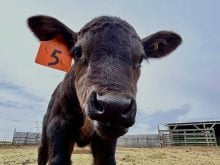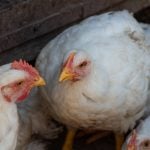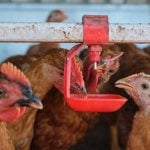In early May a few years ago, I left the safety of the highway and turned onto a muddy summer road. There was a farm on the south side that had about 50 beef cows with little calves living in knee-deep mud. While there was lots of green hay in a bale feeder, the cows looked thin and the baby calves were gaunt. It was a good reminder that muddy living conditions can harm cow-calf performance and health. That is why we must do everything in our power to implement a plan to reduce its effect on cattle.
Research in the U.S. Midwest has demonstrated that very little mud is needed to become a big mess for cattle. As little as four to eight inches of mud was shown to reduce average daily gains in growing dry lot cattle by five to 15 per cent. As mud gets belly deep, cattle performance has been shown to be reduced by as much as 35 per cent.
More specifically, a recent Ohio State University graduate project (2019) compared a group of late-trimester beef cows housed in pens with 10 inches of mud with those pre-calving beef cows housed with 10 inches of mud bedded with a thick layer of bark chips. At the end of the study on day 269 gestation, the cows in the unbedded muddy pens weighed 38 kg less than their bark-chip counterparts. Newborn calf birth weights in both pens were unaffected by pen treatments.
Read Also

Harvest wraps up and fall work begins
At the Eppich famly ranch in western Saskatchewan, the fall harvest was successful with few breakdowns, cows and calves have been sorted and a new tractor has arrived
The graduate student concluded that these muddy cows mobilized one full score of body condition (BCS) of fat to compensate for an increase in dietary energy requirements due to the mud. She also speculated that these calving cows were susceptible to other long-term problems as a result of weight loss, such as a longer post-partum return to first estrus, delayed conception and final lower pregnancy rates.
This thesis did a good job in examining the negative effect of mud on beef cow nutrition and body condition, but made no mention of any lameness. I have personally witnessed many lame cattle struggling through a foot of mud in their pens or on wet early-spring pastures. Previous university extension surveys record that about three-quarters of lameness observed in muddy conditions is due to contagious foot rot bacteria. Pus and discharge from swollen feet contaminate muddy ground and healthy cattle will often become infected within a day if they happen to walk in the same muddy dry lot or pasture.
Multiple disease risks
Several environmental studies have proven that foot rot bacteria can live for about a year in mud. Unfortunately, foot rot is not the only undesirable microbial threat that can live in the mud of dry lots and pastures. Mud is a good home for scour-causing organisms such as clostridial pathogenic E. coli, Clostridium perfringens, salmonella and parasitic protozoa or cryptosporidia and coccidia.
Coccidia protozoa that cause coccidiosis disease are particularly problematic to beef cattle raised in wet, muddy pens or confined pastures. That’s because the organism is shed in the manure of infected cattle. Since most of these cattle often live in close proximity, most come into almost immediate contact with cocci-infested manure/mud. Nursing calves are the most vulnerable to the cocci infections from mud because they could be suckling a mud-encrusted udder and often are not old enough to consume enough creep-ration formulated with a protective coccidiostat such as monensin sodium.
After a bout of coccidiosis that nearly decimated his newborn calf crop about five years ago, a friend who runs a 250-beef cow herd operation took matters into his own hands. He implements a broad-based protocol every spring as he lets his cow herd out on sprouting green pastures:
1. Scrapes down the pens from manure that builds up during the winter.
2. Puts down a bale or two of straw in the middle of the pen.
3. Treats every case of foot rot immediately.
4. Watches out for scouring spring calves and treats them immediately.
5. Utilizes his higher-ground pastures during the spring and avoids wet low pastures.
6. Feeds a mineral on pasture with chelated zinc, proven to harden cattle hooves.
This producer is the first to admit that he can’t escape mud during spring. It’s just something that has to be dealt with every year. He applies his management practices so freshened cows remain at their optimum body condition and in good health for the upcoming breeding season. Keeping calves in a clean environment also helps maintain vigour in newborn calves, which contributes to their heavy weaning weights in the fall.
















